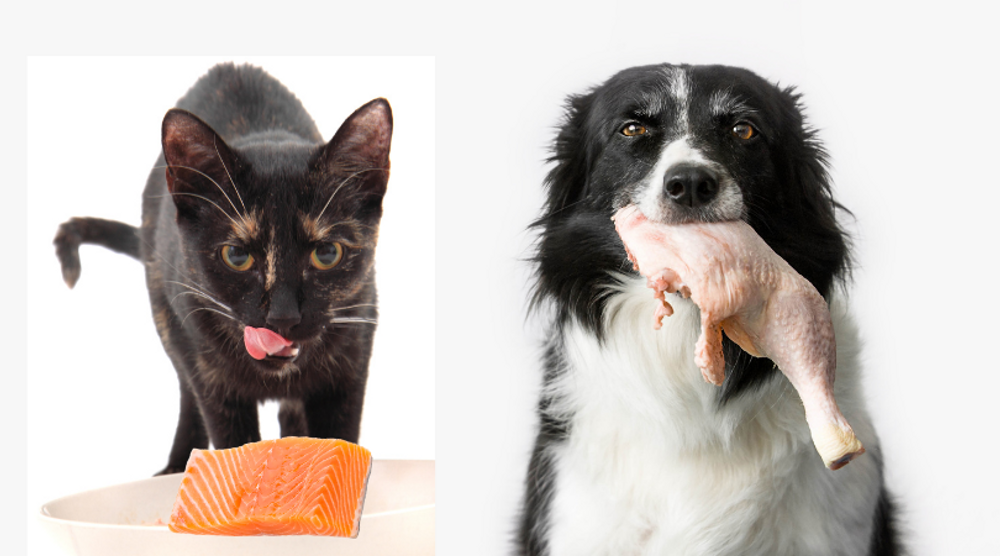Why are Dogs and Cats Meant to be Carnivores?
Posted by Rhonda Jewel on Apr 19, 2017
First have a look at Canine Anatomy
Let’s look at the mouths of canines and felines. Carnivores have a unique dentition that is not found in omnivores and herbivores. This fact alone should begin to create an understanding of why feeding canines meat protein makes nutrients more bio-available and helps them thrive. Their salivary glands are designed to provide lubrication, but they don’t contain the needed enzyme, amylase, to begin digestion in the mouth, as omnivores' saliva does. This is why carbohydrates including all grains, legumes, vegetables and potatoes are not recommended for carnivores.
Prey is not chewed up in the wild, or even in domestic situations, rather, it is gulped, or torn and crushed by the incisors, and then swallowed whole.
If those larger pieces of meat are too chunky or big to get down the gullet, a carnivore will regurgitate it with saliva to lubricate it, and then swallow it again. Ripping and tearing at meat is very primal, and healthy for our pets. It brings out a vitality in cats and dogs that is just not possible with kibble or home-cooked meals with added vegetables or even cooked meat-based meals.
Dr. Tom Lonsdale says in his book, Work Wonders: Feed Your Dog Raw Meaty Bones: “Our pet dogs (modified wolves) deserve the best available - whole carcasses of other animals. By ripping and tearing at food carnivores keep periodontal and associated diseases at bay.”
The Carnivore Stomach
In a carnivore, digestion begins in the stomach. Their stomachs are small, yet very elastic and expandable. Even though their stomachs are small, because the meat and bone ingested are so nutrient-rich they don’t need to eat much to meet their nutritional needs.

However, if they do gorge on a meal, the stomach will expand accordingly. They may not need to eat another meal for several days.
The carnivore’s stomach contains a type of hydrochloric acid that is actually ten times stronger than that of either a human or a herbivore. The pH level of a dog’s stomach when it contains food is quite acidic, about 1, whereas humans and other herbivores have a pH level of about 4 or 5. Another big realization can be that dogs are simply not herbivores, but rather carnivores, who are not like omnivores. They have a highly acidic system to quickly digest meat and move it through their short digestive tracts.
Equally important to the tremendous ability of canines to digest bone and fat is their exceptional bile production. Jennifer Lee, author of Inner Carnivore, says about bile, “The liver produces bile fluid that plays an important role in the digestion of dietary fats. Bile salts are required during digestion to separate fat molecules, exposing more of the surface to digestive enzymes."
Dogs' and cats' small intestines are only about three to six times the length of their bodies. This design configuration allows food to be eliminated quickly. The intestine of most omnivores and herbivores is ten to twelve times the length of the body. Human beings'
small intestines are much longer and wind around inside us, seemingly to retain food
longer for better absorption of nutrients before going into the large intestines.
Dogs' Nutritional Needs:
Canines require 22 essential amino acids to provide them with their daily nutritional needs. However, a dog only produces 12 of the 22. The other ten must come from their diet. Herbivores such as cows, with their multiple stomachs and longer intestines, can produce many more amino acids. The short canine digestive tract is fast-working and very simple. It is not designed to make its own amino acids so they must be obtained directly from food.
It is important that a carnivore's food should provide protein from a wide variety of sources so as to obtain the full spectrum of necessary amino acids, which are found in the following proteins including their organs and bones:
- chicken
- duck
- turkey
- eggs
- fish
- lamb
- beef
- bison
- venison
- Elk
- goat
Protein is crucial to every cell in a carnivore’s body. The full spectrum of amino acids
from animal protein of the highest quality must be provided daily to build healthy cells,
organs, muscles, enzymes and hormones for cats and dogs.
Additionally, animal fat provides the energy needed by your pet for stamina and
endurance, and contains essential vitamins and fatty acids, which are also a very important part of the carnivore diet, and necessary for a healthy coat and skin, for
healing, and for normal cell membrane synthesis and reproduction.
This is the first of many reasons why we can consider dogs and cats obligate carnivores.
What is an Obligate Carnivore?
Obligate carnivores are animals that have genetic structures requiring them to eat animal flesh to thrive. They sometimes eat non-flesh foods opportunistically, including vegetables, fruit, grasses, grains and legumes, but they must consume meat as the main source of their diet or they will not be as healthy as they were meant to be. Many carnivores are forced to survive on foods full of grains and vegetables, sometimes with no meat at all. Unfortunately, they will suffer the consequences and contract conditions and diseases in later life. This is mirrored by humans who suffer from eating the wrong diet.
Cats are totally obligate carnivores. We must eschew the idea of feeding cats a grain based, or even canned or kibble diet, although many people do this with supplementation of the needed nutrients from meat. In our opinion this is wrong. Cats really thrive on fresh, raw meat.
Dr. Jeannie Thomason, in her report, Dogs and Cats, Both Obligate Carnivores, writes:
“The biggest reason many people claim that dogs are not obligate carnivores, and cats are, is that they believe there is no KNOWN nutrient that a dog cannot obtain or synthesize from plant ingredients. They fail to believe what science has proven about the anatomy and physiology of the dog, that proves they do not manufacture the enzymes necessary to break down and utilize any nutrients in plant material. Even when the vegetables are pulverized, very few nutrients can be obtained from them by a canine.”
Can Dogs Be Omnivores?
Comparison of Raw Meat vs. Cooked Diets
Let's recap the facts we already know:
- a) Dogs have canine teeth, not omnivore-type teeth designed to grind vegetables.
- b) Dogs have short digestive tracts incapable of breaking down vegetables and
grains
- c) Dogs don’t have digestive enzymes from saliva in their mouths, which begin to
break down vegetables, legumes and grains, as humans do.
For these and other reasons, plant matter is not easily digested or assimilated and has a tendency to pass through the digestive tract undigested. Therefore, canines have little chance of getting nutrition from plant nutrients.
My thinking is that since wild dogs have rarely eaten grains and cannot easily digest them, then it is illogical to feed domestic dogs any starchy foods at all. Since canines since prehistoric times have only eaten raw foods in the wild, then how can a cooked diet with added sweet potatoes, grains, or vegetables be beneficial? Changes to its chemical make-up when cooking destroys nutrients. Grains and vegetables are more difficult for the dog to digest, cooked or raw.
There is also the argument that raw meat, especially the raw prey model diet, can give your dog more variety, which helps to keep your dog interested in her food. With a vegan diet it is limited to a regular cooked meal, which is not natural to animals. Yet, the argument is that dogs have adapted over the years around camps and villages feeding on humans' scraps. But does that justify feeding dogs cooked foods? Probably not. I feel we are doing an injustice to pets feeding them any cooked food, especially a cooked kibble diet.

